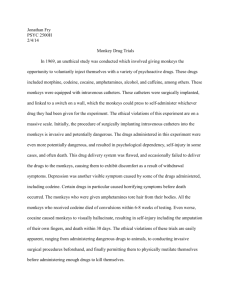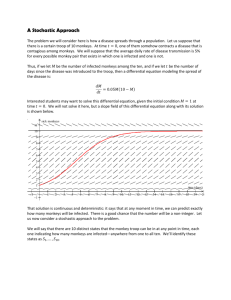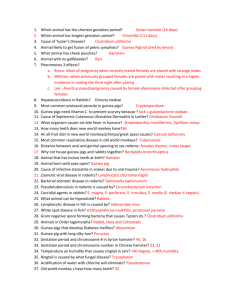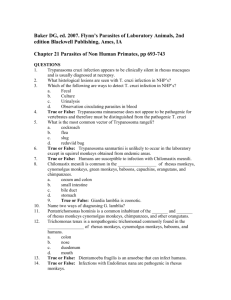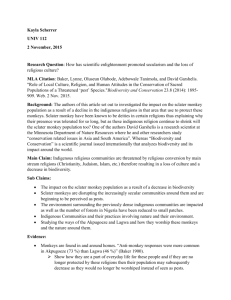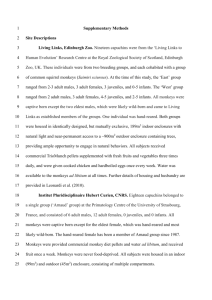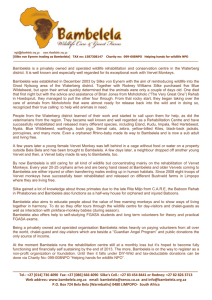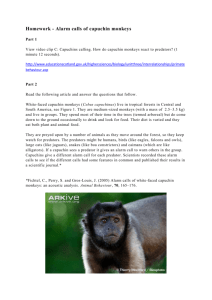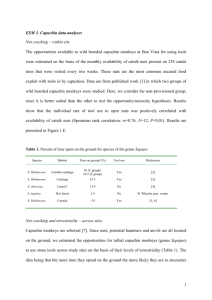Insights into basis for neurodegeneration in PD
advertisement
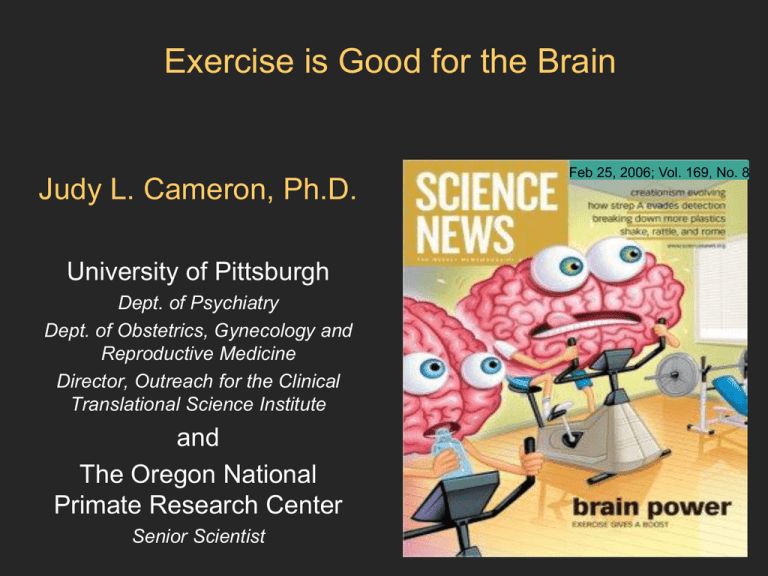
Exercise is Good for the Brain Judy L. Cameron, Ph.D. University of Pittsburgh Dept. of Psychiatry Dept. of Obstetrics, Gynecology and Reproductive Medicine Director, Outreach for the Clinical Translational Science Institute and The Oregon National Primate Research Center Senior Scientist Feb 25, 2006; Vol. 169, No. 8 Experimental Model: Rhesus monkeys and Cynomolgus monkeys Bill Greenough Running wheel Complex environment Cage potato Exercise Training Female Cynomolgus Monkeys Two age groups Middle aged (10-12 years) Older age (15-17 years) Three experimental groups Runners (run 5 months) Sedentary (sit 5 months) Run-Stops (run 5 mo, sit 3 mo) Running protocol 80% max heart rate 1 hr/day, 5 days/week 20 weeks Cognitive Testing: WGTA Monkeys that exercise are more attentive, and learn to use the testing apparatus twice as fast. What is the affect of being more alert and attentive while you are in school?? Running Increases Vascular Volume in the Motor Cortex of Older Animals BrdU-labeled endothelial cell Sedentary Runner Run-Stop Running Increased Neurogenesis in the Hippocampus of Middle-aged Monkeys * * bIII tubulin BrdU Middle age Older age Running Increased the Production of Astrocytes in the Motor Cortex * BrdU * * S100b NeuN Middle age Older age Conclusions: • Exercise increases vascular volume in the cortex, neurogenesis in the hippocampus, and gliogenesis in many brain regions. Clinical Implications: Exercise may counteract changes in the brain with aging, and protect against neurodegenerative diseases (i.e., PD, AD, & stroke) Neuroprotective Effects of Exercise Zhiming Zhang, Ph.D. Univ. Kentucky Michael Zigmond, Ph.D. Rehana Leak, Ph.D. Brian Lopresti, Ph.D. Chet Mathis, Ph.D. Univ. Pittsburgh Karoly Mirnics, Ph.D. Vanderbilt Univ. NINDS: R21 NS053471, P50 NS019608 Parkinson’s Disease Norm Substantia nigra Braak et al., 2004 Lewy body PD Experimental Design Adult, female Rhesus monkeys (15-20 yrs. old) MPTP (0.8 mg) Running (1 hr/day, 5 days/wk) [Sedentary, 60% max hr, 80% max hr] 3 months Running/Sedentary 1.5 months Monkeys with Highest Levels of Physical Activity had the Least Damage to Nigrostriatal Dopamine Neurons [11C] DTBZ Binding Potential (Bmax/Kd) 3.5 Sedentary 60% Max 80% Max 3.0 2.5 r2=0.636, p=0.032 2.0 1.5 1.0 0.5 0.0 0 100 200 Daily Activity Counts (x103) 300 Monkeys with Highest Levels of Physical Activity had the Least Damage to Nigrostriatal Dopamine Neurons 80% 60% SED TH Actin 2.0 Sedentary 60% Max 80% Max TH/β-Actin 1.5 2 r =0.767, p=0.01 1.0 0.5 0.0 0 100 200 Daily Activity Counts (x103) 300 17 Conclusions: • Being more active, regardless of the quantity of aerobic exercise undertaken, can protect DA neurons in the striatum from neurotoxic damage Clinical Implications: Maintaining an active lifestyle may significantly protect the brain against neurodegenerative diseases (i.e., Parkinson ’ s Disease), or be useful in decreasing the rate of progression of Parkinson’s Disease. This is a health strategy that would be accessible to many people regardless of their baseline fitness. Changes in the Brain with Normal Activity Elinor Sullivan, Ph.D. ONPRC Karoly Mirnics, Ph.D. Vanderbilt Univ. Monkeys Have Been Fitted with Activity Monitors There are LARGE individual differences in daily activity levels Does General Activity Affect Health? Monkeys put on a High Fat Diet Show Large Individual Differences in Weight Gain Percent weight gain 190 170 150 130 110 90 70 50 Initial Weight After Ovx 5 mo High fat diet 9 mo High fat diet Only Activity Predicts Body Weight Change in Adulthood Activity 12 10 8 6 4 2 0 p =0.03 Lowest Highest 25% 25% Food Intake 12 10 8 6 4 2 0 p =0.58 Lowest Highest 25% 25% Metabolic Rate 12 10 8 6 4 2 0 p =0.14 Lowest Highest 25% 25% Conclusion: • Being more active is the best way to prevent adult weight gain. Clinical Implications: Maintaining an active lifestyle is very important for preventing adult weight gain and obesity. With 60% of the adult population in the United States overweight, increasing activity is critically important for prevention of obesity-related diseases including heart attacks, strokes, and diabetes. Current and Future Directions • What are the intracellular mechanisms by which exercise modulates neuronal function? • What are the differential effects of high activity vs. aerobic exercise? • Will exercise be useful as a therapy or adjunct therapy in treating: – – – – Substance abuse (smoking: Drs. Kupfer, Soreca and Monk) Depression and Bipolar Disorder (Drs. Kupfer, Frank) Neurodegenerative diseases (Drs. Zigmond, Zhang, Mirnics) Normal aging (Drs. Zigmond, Mirnics) Physiological Studies Nathan Rockcastle Joan Bytheway, Ph.D. Kris McCormick Henry Lange Matt Johnson Maria Centeno, Ph.D. Neuroanatomy Sean Kohler Jenny Boklewski Georgina Aldridge Robert Galvez Biochemistry, Gene Expression Amanda Mitchell, Ph.D. Krassimira Garbett Amanda Smith, Ph.D. Sandra Castro Questions?

